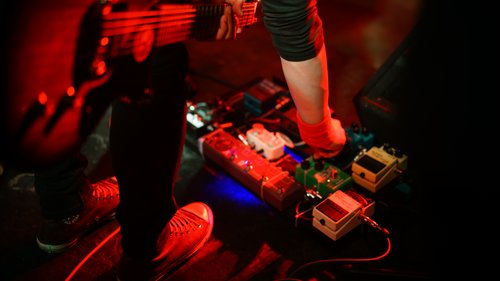
Essential Guitar Sounds
This one’s for all you guitar players in the room.
Let’s talk about tone. Many legendary guitarists are quick to say “it’s all in the fingers”, which is true—to a degree. Yes, you want to make sure you can play all of your lead parts, scales and chords with finesse, but having a good toolbox of effects and accessories can introduce compelling sonic elements to your sound.
Contemporary worship guitar has become a bit of a genre in its own right. It serves to add texture and ambiance, while simultaneously supporting melodies and countermelodies. Below is a list of some practical effects to keep in your arsenal. Each example has three different pedals suggested for three different price ranges.
Delay
Possibly the most necessary effect to have at your disposal as a worship player. Rather than actually delaying the sound, as the name might suggest, this effect rhythmically repeats your tone. Delays are almost always adjustable so that you can dial in how loud, long, and fast the repeats sound. “Delay swells” are heard in dozens, if not hundreds, of modern worship songs. This is when you play a chord or note with the volume all the way down, then turn the volume up gradually. This creates a “swell” or “pad” texture. Swelling with delay sustains the tone and allows it to linger. It also allows you to overlap your swells for greater ambiance.
Strymon Timeline – $449
Line 6 DL4 – $249.99
MXR Carbon Copy – $150
Reverb
Delay’s sonic cousin, reverb emulates the sound of the tone in a room. Short reverbs mimic a small room, while long mimics large rooms. “Dry” is the term used to describe a small or quiet amount of reverb, while “wet” is used for lots of or reverb. This simple effect is extremely effective in creating space and, again, texture. The difference between between a dry and wet tone can be stark. Reverb is used on almost every song of every genre.
TC Electronics Hall of Fame – $149.99
EarthQuaker Devices Afterneath – $229.
Strymon BigSky – $479
Overdrive and Distortion
Maybe the most common pedal, but also the most misunderstood. Overdrive is meant to mimic the natural distortion that comes from tube powered amps. When a tube amp is driven, or turned up, the hot tubes distort the tone. This effect can be used very subtly, or overtly. It can add a richness and boldness to tone, but when applied too heavily, you can easily get into heavy metal territory. They often come equipped with a volume, tone, and gain or drive knob. A common practice for beginning guitarists is to have the guitar volume and tone up all the way, while relying on pedals to manipulate your tone. Overdrive pedals respond quite dynamically to your guitar tone and volume. When you turn the volume up or down on your guitar, it will raise or lower the gain level on the pedal.
*My general practice is to always keep my guitar volume at 7, and set my gain and volume knobs a bit higher on the pedal. This allows me to have some headroom to my max volume so I can turn up for a lead part without having to kick on a pedal. This gives me the control, not the pedal. It also makes for a smoother transition between tones.

TC Electronics Mojomojo – $49.99
Fulltone OCD – $127.20
JHS Double Barrel – $315
Modulation
Chorus, flange, phasers, ring mods, synths, sweet cheese and crackers there are a lot of options. “Mod” pedals are used to add movement and depth to your tone and do so by rhythmically shifting your volume (such as tremolo and vibrato) or your frequency (such as chorus and phase) Best if used sparingly or “on slow settings”, as they can quickly make your soaring solo sound like a cheesy sci-fi movie soundtrack.
Electro-Harmonix Good Vibes – $137.40
Pigtronix Tremvelope – $199
Blackstar HT-Modulation – $299.99
Multi-Effects
Building a tricked out pedal board can get expensive…fast. Multi-effects are a great way to expand your sonic pallet for a fraction of the cost. They’re also easy to move and set up for quick gigs and practices.
BOSS ME-80 – $299.99
Roland GR-55 – $799.99
Line 6 Helix LT – $999.99
Accessories
Smaller items that don’t belong on a pedal board, like slides and Ebows, can also have dramatic and tasteful effects. Slides might be more familiar; they’re small tubes of usually glass, metal or ceramic, that fit over your ring or pinky finger, and allow you to slide up and down to notes. This is great for creating a singing effect. Ebows are less common, but just as fun. They are small electronics that you rest onto the string with your strumming hand and create a “bowed” effect, like a violin or cello.
Ebow – $99.99
Dunlop Glass Slide – $4.99
A word to the wise, be mindful of your effects. They are incredibly fun to play around with and coax far out sounds, but you’ll quickly find that heavy effects do not sound good in a whole band context. Use your solitary practice time to dial in the tones and textures you think will work well, then try them out during rehearsal with the band. During service is the last place you want to be tinkering with pedal settings.
These are just a small handful of the available effects for guitar. There are literally thousands of pedals made by hundreds of different companies. It’s a rabbit hole that’s easy to get lost in, so if you’re just starting out, definitely start with a few of the ones we’ve listed above
(and don’t forget to check with your spouse before buying the Strymon Big Sky!).